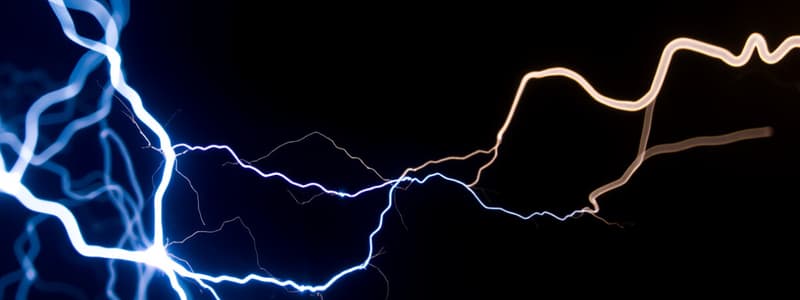Podcast
Questions and Answers
What is the unit of measurement for electric charge?
What is the unit of measurement for electric charge?
- Coulombs (correct)
- Volts
- Joules
- Amperes
The larger the magnitude of the electric charge, the weaker its interaction with other charged particles.
The larger the magnitude of the electric charge, the weaker its interaction with other charged particles.
False (B)
What is the formula for Coulomb's Law?
What is the formula for Coulomb's Law?
F_E = k * (Q * q) / r^2
The electrostatic force is a non-contact force analogous to _______.
The electrostatic force is a non-contact force analogous to _______.
Match the following variables in Coulomb's Law with their meanings:
Match the following variables in Coulomb's Law with their meanings:
Which of the following statements is true about electric fields?
Which of the following statements is true about electric fields?
Coulomb's Law is an example of an Inverse Square Law.
Coulomb's Law is an example of an Inverse Square Law.
What is the value of Coulomb's constant approximately?
What is the value of Coulomb's constant approximately?
What does the field density represent?
What does the field density represent?
A positively charged particle moves towards the negative plate in an electric field.
A positively charged particle moves towards the negative plate in an electric field.
What is the term used for the capacity of charged objects to do work due to their position in an electric field?
What is the term used for the capacity of charged objects to do work due to their position in an electric field?
The equation for work per unit charge is represented as 𝐸 × 𝑑 = _____
The equation for work per unit charge is represented as 𝐸 × 𝑑 = _____
Which of the following scenarios describes a particle doing work on the field?
Which of the following scenarios describes a particle doing work on the field?
A particle with a Net Charge of zero will not interact with the electric field.
A particle with a Net Charge of zero will not interact with the electric field.
What do you obtain when you multiply the electric field strength by the distance between plates?
What do you obtain when you multiply the electric field strength by the distance between plates?
Match the following components with their definitions:
Match the following components with their definitions:
Flashcards are hidden until you start studying
Study Notes
Electric Charge and Measurement
- Electric charge (q) is a fundamental property of matter influencing interactions with electric and magnetic fields.
- Measured in Coulombs (C), the charge is a whole number multiple of ±1.602 × 10^−19 C, which is the charge of protons and electrons.
- Greater charge magnitude increases interaction strength with other charged particles.
Coulomb's Law
- Describes the electrostatic force between charged particles, analogous to gravitational force.
- Formula: 𝑭𝑬 = 𝒌𝑸𝒒 / 𝒓^2
- 𝑭𝑬 = electrostatic force (N)
- 𝒌 = Coulomb’s constant ≈ 9 × 10^9 N m²/C²
- 𝑸 = larger charge (C)
- 𝒒 = smaller charge (C)
- 𝒓 = distance between charges (m)
- Coulomb's Law follows an Inverse Square Law: force decreases as distance increases.
Electric Fields
- Electric fields are vector fields indicating the direction of force on positive charges.
- Represented by arrows pointing away from positive charges and toward negative charges.
- Electric Field Strength (𝑬) defined as:
- 𝑬 = 𝑭𝑬 / 𝒒 = 𝒌𝑸 / 𝒓^2
- 𝑬 = electric field strength
- 𝑭𝑬 = electrostatic force (N)
- 𝒒 = charge of the particle (C)
- 𝒓 = distance from the charge (m)
Uniform Electric Fields and Field Density
- A uniform electric field is created between parallel positively and negatively charged plates.
- Field density is the number of electric field lines and serves as a graphical representation of field strength.
Electrical Potential Energy
- Electrical potential energy represents the capability of charged objects to do work within an electric field.
- Particles may interact with the field:
- Field does work on particle:
- Positive particle accelerates toward the negative plate.
- Negative particle accelerates toward the positive plate.
- Particle does work on field:
- Positive particle moves toward the positive plate.
- Negative particle moves toward the negative plate.
- No work:
- A particle moving perpendicular to the field experiences no work done by or on the field.
- Field does work on particle:
Work and Voltage Relationship
- Electric field, defined as force per unit charge, relates to work and voltage:
- Formula: 𝐸 × 𝑑 = 𝑊 / 𝑞 = 𝑉
- 𝑬 = electric field strength
- 𝒅 = distance between charges or plates (m)
- 𝑭𝑬 = electrostatic force (N)
- 𝒒 = charge (C)
- 𝑾 = work done (J)
- 𝑽 = voltage (V)
- Formula: 𝐸 × 𝑑 = 𝑊 / 𝑞 = 𝑉
Studying That Suits You
Use AI to generate personalized quizzes and flashcards to suit your learning preferences.




